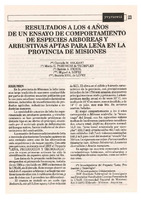Resultados a los 4 años de un ensayo de comportamiento de especies arbóreas y arbustivas aptas para leña en la provincia de Misiones
Results of a trial of the behaviour of species of trees and shrubs apt for firewood, in the province of Misiones
Date
1991-09-01Author
Volkart, Conrado Máximo
Parussini de Trümpler, Marta Gladys
Friedl, Ramón Alejandro
López, Miguel Ángel
Eibl, Beatriz Irene
Metadata
Show full item recordAbstract
En la provincia de Misiones la leña tiene una larga tradición de uso como combustible por parte de diversos usuarios: población que la usa para satisfacer necesidades domésticas básicas, industrias de transformación de productos agrícolas, industrias forestales e industrias menores.
La cantidad de usuarios de leña ha experimentado un constante aumento, y simultáneamente se han presentado problemas de distinto tipo en su oferta: el principal, ocasionado por el acelerado grado de deforestación del bosque nativo, fuente tradicional de abastecimiento del combustible.
La creación de fuentes adicionales de leña a través de plantaciones forestales aparece en este contexto como una de las alternativas más expeditivas y de mayor interés. Con este pensamiento, se encara en el ISIF el Proyecto “LEÑA, PRODUCCIÓN Y TECNOLOGÍA’, una de cuyas primeras acciones ha sido la identificación de especies aptas para tal fin.
Los datos de la presente contribución corresponden al primero de los ensayos, instalado en 1984 y concluido en 1988 en terrenos de la UNaM, en Eldorado. Este ensayo abarcó un total de 8 especies arbóreas y arbustivas exóticas (una de ellas con 3 cultivares distintos, y uno de éstos con 3 procedencias diferentes).
El ensayo se instaló en un suelo tipo Rodocrult, con pH 5,2 en agua y 4,3 en solución de KCl. El clima es el cálido y húmedo característico de la provincia, con precipitaciones del orden de los 1750 mm anuales, que ocurren principalmente en otoño y primavera. La temperatura media anual es de unos 20° C, con medias de 25°C en enero, mes más cálido, y de 14° C en julio, mes más frío. En invierno ocurren heladas.
El mejor comportamiento a los 4 años correspondió a Mimosa scabrella, la “bracatinga” del Brasil, con los siguientes valores medios de los diversos parámetros considerados: altura total: 10,90 m; diámetro normal: 14,3 cm; “área basal acumulada por ejemplar”: 250,7 cm2; área basal/ha: 62,7 m2; volumen sólido/ha: 343,7 m3; volumen estéreo/ha: 646,3 m3; peso total del material “oreado”/ha: 364 ton. Le siguen en ese orden: Paraserianthes falcataria (sin. Albizia falcataria), Leucaena diversifolia y Acacia mangium.
Se agrega un sucinto comentario sobre características botánicas, silviculturales y tecnológicas de estas especies, como así sobre sus usos. In the Province of Misiones, firewood has a long tradition of use as fuel by several users: people that employ it to satisfy basic domestic energy needs, transformation industries of agricultural products, forestry industries and minor industries.
Users of firewood have increased firmly in number; at the same time different problems arised in their offering, the most important being the accelerated depletion rate of the traditional source of fuel supply, the native forests.
The creation of complementary fuelwood sources through forest plantations appears as one of the most expeditive and interesting alternatives in this context. With this in mind, ISIF undertakes the “Firewood, Production and Technology” Project, in which one of the first actions was the identification of convenient species.
The present contribution data came from the first trial, started in 1984 and finished in 1988 in UNaM’ lands in Eldorado. This trial included a total of eight exotic species of trees and shrubs (one with three varieties, and one of which with three different provenances).
The trial was laid out in a Rodocrult soil, with pH 5.2 in water and 4.3 in KCl solution. The climate is that warm and wet typical of the Province, with annual rainfalls of about 1,750 mm occurring mainly in Autumn and Spring. Mean annual temperature is about 20° C, with mean values of 25° C in January, the warmest month, and 14° C in July, the coldest one. Frosts are present in Winter.
The best behavior at age 4 was showed by Mimosa scabrella, the “bracatinga” from Brazil, with the following mean values for the different parameters considered: total height: 10.90 m; diameter at breast height: 14.3 cm; “accumulated basal area per tree”: 250.7 cm2; basal area per hectare: 62.7 m2; solid volume per hectare: 343.7 m3; stere volume per hectare: 646.3 m3; “oreado” material total weight per hectare (“oreado” being material dried for 1 month in natural conditions): 364 tons. “Bracatinga” is followed, decreasingly, by Paraseriantes falcataria (sin. Albizia falcataria), Leucaena diversifolia and Acacia mangium.
Brief comments about botanical, silvicultural and technological characteristics of these species are added, and also about their uses.
Collections
- Revista Yvyraretá [360]
The following license files are associated with this item:




